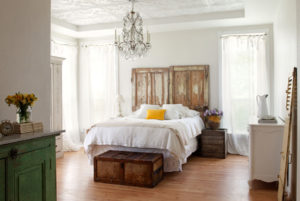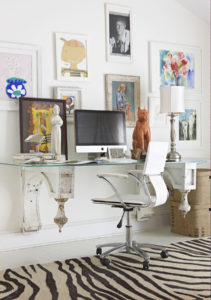Salvaged architectural details lend a clever and
interesting vibe to these homes. Channel some of these ideas in your own home to
craft a new look that feels both trendy and timeless.

Choose
a primitive headboard.
A pair of doors, likely from a barn or an outbuilding, rise
as a standout headboard. Their weathered finish, rusty hardware and substantial silhouettes
make a period-perfect statement. Before using worn architectural elements near
sleeping or eating areas, sand away chipping paint. Seal all surfaces with a clear
sealer to ensure the piece retains its patina but won’t shed any paint chips or wood
slivers.

Be
progressive.
Even the most ancient of salvaged architectural materials
have a place in contemporary spaces. Old-world corbels complete with finial
details fashion a digital workstation. The corbels, which likely once supported
some type of roof or overhang, handily prop up a glass desktop. Duplicating
this idea? Make sure you secure the corbels into wall studs so they support the
weight of the desktop, office equipment and desk decor.

Draw
parallels.
Distressed finishes—be they artificially applied or naturally occurring—visually connect architectural
salvage and antique furnishings. Here, a timeworn mantelpiece subs in as a faux
fireplace; a decorative trim piece and a rusty iron frieze heighten interest on
the wall behind an iron bedstead; and a paneled shutter stands tall atop a
nightstand to support a vintage sconce.

Go
from door to table.
A vintage door converts to a handsome dining table when equipped with a
trestle base. A whitewash finish unites the new and old elements.

Make
it a window to the world.
Take time to think about how you can best revive a time-tired
architectural element. Turn it this way and that until inspiration strikes. A
vintage half-arch window becomes even more appealing when used to frame a
quartet of faded maps. To get a similar look, adhere maps to glass panes that
remain in the frame. Missing glass panes? Mount maps, photos or meaningful motifs on
cardboard or glass pieces cut to fit the window openings.

Make
a vintage reflection.
Think of a multipane window as a framework for all sorts of updates. Tall and
graceful, this arched window converts to a focal-point mirror that suits the
entryway’s
elegant leanings. One piece of mirrored glass was cut to fit the window and
secured to the back of the window frame. Opt for mirrored glass with an
antiqued finish to give the newly constructed piece an authentically aged look.

Make
modern adaptations.
Antique doors replete with rusty grilles and worn green
paint enclosing a bedroom doorway evoke images of medieval entries and secret garden gates. A vintage
baluster shines as a bright light thanks to a lamp-wiring kit, some expert
drilling and a simple white drum shade. An old column beefs up the
window trim.

Display
decorative windows easily.
Beautifully patterned leaded-glass windows and
stained-glass panels deserve a place in the limelight. There’s no easier way to display the
artistic elements than by suspending them in a window using screw eyes and cup
hooks. At first glance, these two decorative windows appear to be inset into
the trim because they nearly match the size of the built-in windows. But
smaller windows would work just as nicely to give the existing windows a fresh
point of view.

Make
a perfect pair.
Grab up matching pairs of any type of salvaged
architectural element. You’ll find that having multiples of similar objects
considerably stretches your design options, a point handily illustrated by
these two columns, which fashionably frame a front door while performing as
pedestals for antique garden ornaments.

Create
cozy character.
Reclaim an ornate mantel and use it to amplify your
bedstead’s
presence. This bed’s tufted headboard fits snugly inside the fireplace
surround’s
opening to fashion a juxtaposition of soft and hard. An exhibit of
equestrian-related gear and imagery echoes the look of displays traditionally
arranged on and around a fireplace.

Add
architectural knickknacks.
Collect fetchingly figured fence and furniture finials and
wood and iron brackets to display as sculptures in bookcases, on mantels and atop columns. Here,
weathered brackets and finials of different shapes and sizes provide rustic
counterpoints to displays of fine china, transferware and ironstone pieces.

Make
a statement.
You don’t need an entire mantel or a complete fireplace surround to
create a statement. This carved mantelpiece—once part and parcel of a larger
mantel—steps
up as a good-looking bathroom furnishing. It provides an interesting shape, a
mirror that accommodates primping and shelves for displaying antique bottles, pieces of coral and a vintage vessel.

Make
new media look old.
It’s always a challenge to place a television set in a
vintage-style family room. The screen needs to be seen when a favorite program’s on tap but hidden during
non-TV hours. These homeowners met the challenge by building a media cabinet from an old cupboard door,
which they hinged to side panels. Raised embellishments, a crown-molding cap and a beveled mirror give
the modern media cabinet the look of an antique mantelpiece.

Apply
some character.
Decorative moldings—whether used to trim walls, windows or doorways—offer a wealth of design
opportunities. Here, built-up moldings add sophisticated substance to an
expansive stretch of mirror. If your mirror is already attached to the wall,
simply use a heavy-duty adhesive to adhere recycled trim pieces directly to the
mirror. Miter corner joints to create the look of a finely made frame.

Harness
the power of one.
Just one component in a much larger fireplace surround,
this cast-iron arch supplies a striking silhouette that captures attention. The
arch once likely housed a small door, but now it acts as an art piece that
showcases a pretty flower-filled pitcher.

Use
exterior elements inside.
Exterior architectural elements, such as salvaged shutters,
pediments, corbels and porch columns, come inside to further a vintage look.
These narrow shutters align along the window trim to add old-timey texture to
the wall and make the window appear larger than its dimensions.

Lend
cachet with casements.
Salvage multipane window frames with old-fashioned forms to
use as fab foundations for staging sentimental exhibits of ancestral portraits,
family photos, botanical prints or souvenir postcards. Hang glassless window frames by
screwing two screws into wall studs or wall anchors; set the frame on the
protruding screws. Use removable adhesive or decorative tacks to mount a
variety of quick-change collages. (You may want to use copies of the photos to
preserve the originals.)

Puzzle
things together.
These homeowners saw a whole much greater than the pile of
salvaged house parts awaiting their creative hands. Victorian-era porch columns
complete with spandrel details stand as posters for the bed frame; a flat door
becomes the headboard; and a sidelight inset with tin ceiling panels crafts a
mighty fine footboard. Pieces of reclaimed wood create a canopy that completes
the bedstead’s
timelessly appealing four-poster silhouette.

Make
a vintage kitchen vibe.
Vestiges from residences past give this kitchen period
panache. Tin tiles deck the ceiling with vintage texture and shine. Metal tiles
and distressed beaded board fashion a distinctive backsplash. Shapely corbels
distinguish the island while supporting a family-friendly breakfast bar.

Lend
renewed purpose.
Pediments provide classical embellishment on exterior
facades and fine furniture pieces. Salvaged versions, like the one displayed
above this fireplace, endure as perennially pleasing artworks, thanks to their
intricate carvings and noteworthy forms. Another interesting shape pops up in
this living room: the coffee table is crafted from a salvaged window boasting a porthole-like
form.


